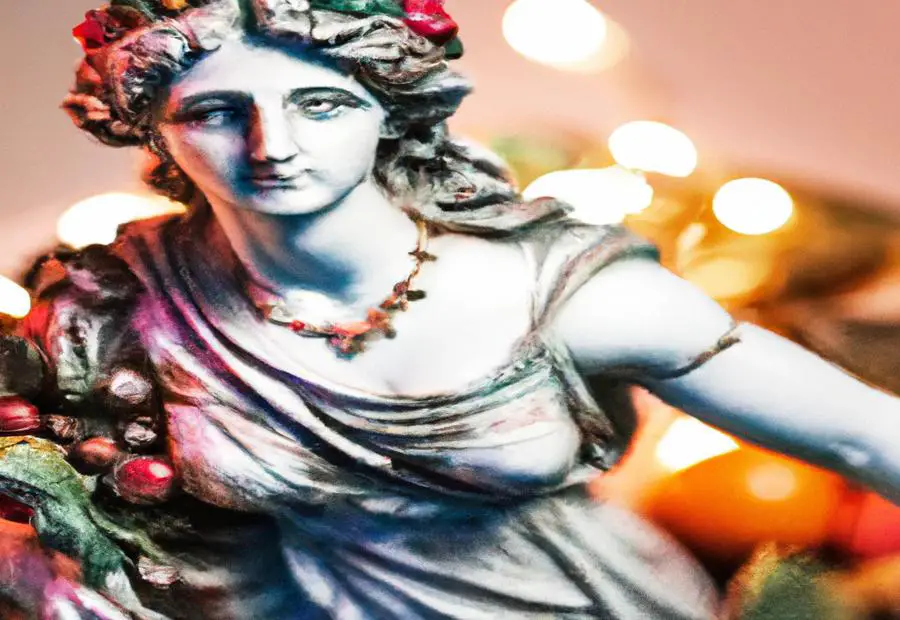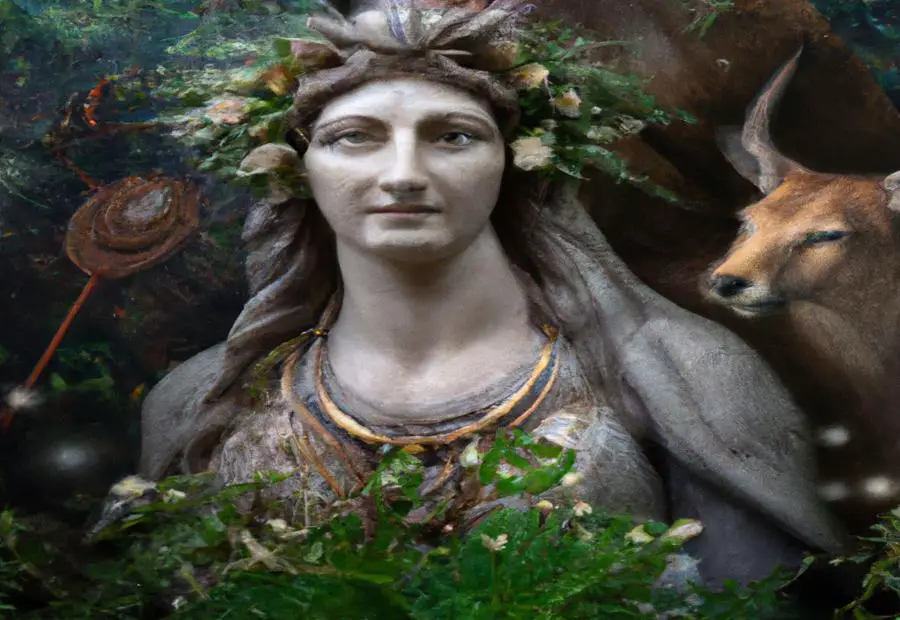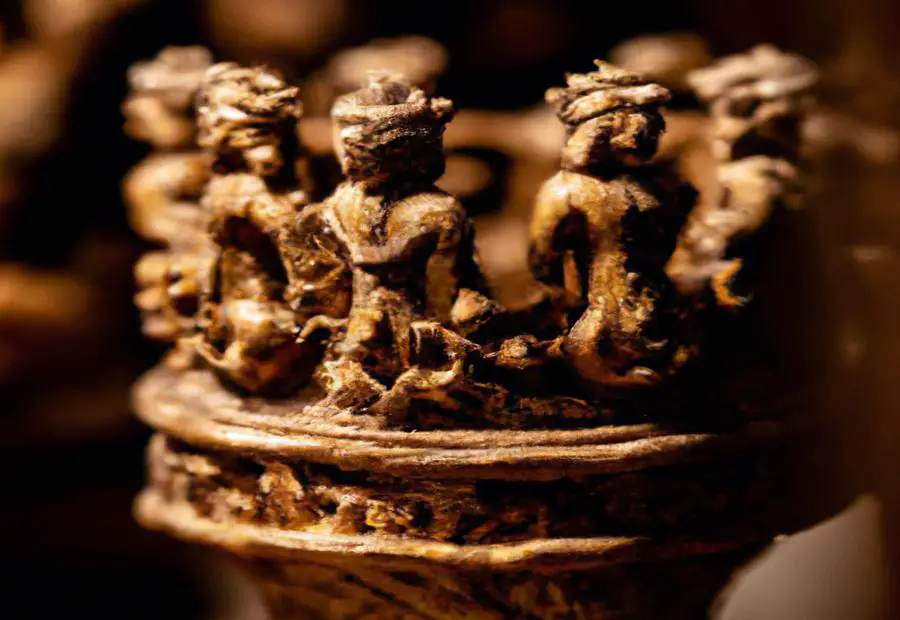Last Updated on July 9, 2023 by Francis
.jpg)
Contents
Key takeaway:
- Offerings for Artemis can be categorized into different types, including food offerings, libation offerings, votive offerings, and charitable offerings. These offerings play an important role in honoring Artemis and seeking her blessings.
- Food offerings are a common way to honor Artemis, with various foods such as fruits, honey, and bread being offered to her. These offerings symbolize nourishment and abundance.
- Libation offerings involve pouring liquids, typically wine, as an offering to Artemis. This act symbolizes the sharing of drink and strengthens the connection between the worshipper and the goddess.

Photo Credits: Meaning-Of-Number.Com by Ronald Hernandez
Artemis, a prominent figure in Greek mythology, holds great significance as a Greek goddess. In this section, we will explore her fascinating role and delve into her mythological background. From her association with the moon and hunting to her fierce and independent nature, Artemis captivates us with her unique attributes. Join us as we uncover the tales and symbolism surrounding this revered goddess from ancient Greece.
Artemis in Greek mythology
Artemis is an iconic figure in Greek mythology. She is viewed as a fierce and free-spirited goddess related to the outdoors, hunting, and fertility. Her bow and arrows show her duty as a guardian of nature.
She is Apollo’s twin sister and Zeus and Leto’s daughter. Artemis figures prominently in many myths and stories in Greek history. She is respected for her hunting skills and stands for the wild beauty of nature and its strength. All genders revere her as a symbol of female liberation and autonomy.
Her depiction varies between areas in Ancient Greece, but all of them recognize her association with mother nature and her virginity. This adds to her identity as a figure of purity, chastity, and safety for young women.
In conclusion, we have discussed Artemis’ part in Greek mythology and her meaning in Ancient Greece. She is represented as a powerful female who safeguards wildlife and symbolizes female freedom. Nevertheless, there are many more facets of Artemis’ character that are still to be examined in regards to Greek mythology.
Artemis as a Greek goddess
Artemis is renowned as one of the most powerful Greek goddesses. She is linked to wilderness, childbirth, and hunting. She is seen as a shield and protector of women and girls. Her strength and independence symbolizes femininity.
Often portrayed with a bow and arrow, Artemis embodies physical and spiritual might. She is known for her eternally-remaining virginity, and commands respect and fealty from followers.
When assessing Artemis as a Greek goddess, her part in guiding people through life is highlighted. She oversees childbirth and gives help and safety to pregnant women. This demonstrates her gentle motherly nature as well as her hunting strength. Her complexity reflects the intricacy of human existence.
Researching Artemis as a Greek goddess shows that she has been worshipped for thousands of years in ancient Greece. People offered up prayers and sacrifices or made promises to Artemis, demonstrating her great influence on individuals and society.
It is known that Artemis likes food, drinks, gifts, and charity. Even goddesses cannot resist a good spread!
Explanation of the different types of offerings for Artemis

Photo Credits: Meaning-Of-Number.Com by Gary Davis
Throughout history, followers of Artemis have made various types of offerings to the goddess. In this section, we will explore these different offerings, including food, libations, votive objects, and charitable acts. Discover the significance and rituals associated with each type of offering, as we delve into the fascinating world of showing devotion to Artemis.
Food offerings for Artemis
Artemis, the Greek goddess, was highly respected. People made offerings to honor and please her. Food offerings for Artemis were one type of offering.
A table can show the food offerings given to Artemis. This included items like fruits, grains, honey, and meat. For example, pomegranates and grapes signified fertility and abundance. Barley and wheat represented sustenance and prosperity. Honey symbolized the sweetness of life. And, meat from animals such as deer and boar was offered to honor Artemis’ connection to hunting.
These offerings differed depending on the occasion or personal preference. They were chosen for their importance and meaning related to Artemis’ domains and attributes.
You can show devotion to Artemis by pouring out libations. Just don’t let it spill onto her sacred deer carpet!
Libation offerings for Artemis
Worshipping Artemis involves offering various libations. These can be wine, honey, milk, or water. Wine signifies fertility and prosperity. Honey signifies abundance and bounty. Milk stands for motherhood, femininity, and nurturing. Water represents purification and cleansing. Worshippers can creatively express their devotion through these offerings while still following ritual practices.
Votive offerings for Artemis
Votive offerings to Artemis are an important part of worshiping the goddess. They symbolise devotion, gratitude and reverence. Offerings can be statues, jewelry, weapons, personal belongings or even animal sacrifices like deer or boar. These offerings are placed at shrines or sanctuaries dedicated to the goddess.
There is a deep spiritual connection between worshippers and Artemis. Through offerings, they communicate their hopes, fears, desires and gratitude. Artemis represents various aspects of nature, fertility, childbirth, hunting and protection.
Each votive offering holds a unique story. It can be a wish fulfilled or a blessing bestowed upon them by the deity. These offerings reveal stories of individuals and collective rituals associated with worshipping Artemis.
Donating to the goddess is not only a great thing to do for your soul, but also counts as a tax-deductible donation! What a great deal!
Charitable offerings for Artemis
Artemis values compassion and generosity. Her worshippers honour her by engaging in charitable acts. These may include:
- Funding animal shelters or wildlife conservation projects.
- Donating food, clothing, or resources to disadvantaged individuals or communities.
- Contributing to educational programs or scholarships.
These offerings show commitment to Artemis’ ideals, and a desire to make a positive change in the world.
Description of sacred animals and plants associated with Artemis

Photo Credits: Meaning-Of-Number.Com by Bruce Taylor
Artemis, the Greek goddess of the hunt, had many sacred animals and plants associated with her. For example, the deer represented her connection to the wilderness and hunting prowess. The bear stood for her protective and nurturing qualities. The cypress tree, with its dark green foliage and slender shape, symbolized her bond with nature and role as protector.
The boar was also closely linked to Artemis. This fierce creature signified her relentless pursuit of justice and ability to protect her domain. The laurel tree showed her eternal presence and guiding force in the natural world. The snake, a symbol of transformation and renewal, represented her part as a goddess of fertility and childbirth. Lastly, the anemone flower’s delicate petals and colors symbolized her connection to the seasons.
It is clear that Artemis’ dominion extended beyond the hunt. The symbolism of the animals and plants demonstrate her multifaceted nature as protector, nurturer, and guide in the natural world. This complexity of Artemis’ character and her importance in ancient Greek mythology is evident.
Significance of the number six and the sacred colors associated with Artemis

Photo Credits: Meaning-Of-Number.Com by Roy Gonzalez
The number six and the sacred colors of Artemis are very important. In Greek mythology, six was linked to Artemis as it signifies harmony and balance. These six colors – white, silver, yellow, red, black, and golden – were connected to her attributes. They played an essential role in worshipping her. Each had its own meaning, symbolizing her divine nature and powers.
Moreover, six is thought to show the six stages of Artemis’s life. Also, the colors are connected to animals, plants, and elements, revealing her bond with nature. Evidence is scarce, yet the number six and colors are symbols of Artemis’s divine power. Gaining insight into Greek mythology allows us to understand the admiration given to her.
Overview of the sanctuary of Artemis and its activities

Photo Credits: Meaning-Of-Number.Com by Adam Lopez
The sanctuary of Artemis holds a fascinating array of activities and offerings. Get ready to explore the captivating location of this sanctuary and discover the intriguing votive offerings that have been found there. Unveil the secrets and significance behind this ancient site dedicated to the goddess Artemis.
Location of the sanctuary of Artemis
The sanctuary of Artemis is a sacred spot with special importance in Greek mythology. It is a place to honor the goddess Artemis. It was chosen with much thought, to make sure it would be suitable for worshipping and doing rituals for Artemis.
The sanctuary has a spiritual connection to both worshippers and the goddess. Artemis was revered as a goddess of hunting, animals, childbirth, and girls. Its location shows this reverence. People can come here to honor Artemis through offerings, prayers, and other religious practices.
The sanctuary has different structures for different aspects of worshiping Artemis. These include temples, altars, statues, and groves. There are also specific areas for activities such as offering food, libation ceremonies, dedications, and charity.
It is interesting how the location affects these activities and meanings. For example, people may offer food at altars to thank Artemis or seek blessings. Libation ceremonies involve pouring liquid offerings onto ground or into vessels in designated areas.
Votive offerings found in the sanctuary of Artemis
In regards to votive offerings found in the sanctuary of Artemis, there were various types. These ranged from jewelry and pottery, to works of art. Examples include mythological statues, intricately carved figurines, and even gold and silver.
The offerings often mirrored the interests and needs of those who offered them. For instance, hunters would give hunting equipment or game animal depictions. Women hoping for fertility might offer mother-child sculptures.
In order to understand the significance of votive offerings in archeology, one must look at the material qualities and the context in which they were found. The location within the sanctuary and any inscriptions or dedicatory texts can provide clues to the intentions behind these offerings and the religious practices and beliefs around Artemis.
Conclusion highlighting the insights provided by the votive offerings and the beliefs associated with the sanctuary

Photo Credits: Meaning-Of-Number.Com by Keith Campbell
Votive offerings provide insights into the religious practices and beliefs of a community. These artifacts, dedicated to gods and goddesses, tell individual stories about spiritual connections and desires. With their analysis, recurring themes, patterns, and the evolution of religious practices can be identified. Further, the offerings can be used to deduce the beliefs associated with the sanctuary. Through the study of these offerings and unique details of the sanctuary, researchers can gain a comprehensive understanding of the religious system that thrived within it. Such insights are invaluable for appreciating the rich religious heritage of the community.
Some Facts About Offerings for Artemis:
- ✅ Goat meat was Artemis’s favorite sacrifice, but any game meat or rabbit would also suffice. (Source: Church of Asphodel)
- ✅ Organic and free-range options were preferred for meat offerings to Artemis. (Source: Church of Asphodel)
- ✅ During the Mounukhia festival, round cakes called amphiphontes with tiny torches were offered to Artemis. (Source: Church of Asphodel)
- ✅ Honey, especially wildflower or raw honey, was appreciated by Artemis. (Source: Church of Asphodel)
- ✅ Votive offerings to Artemis included images, clothing, hunting tools, masks, flowers, and animal-related items. (Source: Church of Asphodel)
FAQs about Offerings For Artemis
What are some traditional offerings for Artemis?
Traditional offerings for Artemis include goat meat, game meat, rabbit, animal-shaped cookies, and round cakes topped with candles. Libations such as red wine or blood-colored beverages like cranberry juice are also appropriate. Honey, especially wildflower or raw honey, is appreciated, as are organic and free-range options for food offerings.
Which herbs are associated with Artemis?
Some herbs associated with Artemis are cypress, chamomile, thyme, lavender, mugwort, birch, juniper, mint, pine, rosemary, sage, thistle, yarrow, angelica, bay laurel, coriander, and dill. Each herb has its own metaphysical properties and can be used in various ways, such as burning as incense, making tea, or offering in a vase.
What is the best time to worship Artemis?
The best time to worship Artemis is during the night when the Moon is out, as she is a moon goddess. Monday, associated with the Moon, is especially powerful during the Full Moon. Thursday, associated with Jupiter, is ideal for rituals related to prosperity and abundance. Performing rituals and spells outdoors in nature can enhance the connection with Artemis’s energy and the elements.
What offerings were made in ancient Greece to honor Artemis?
In ancient Greece, offerings to honor Artemis included goat meat, game meat, rabbit, round cakes with candles, honey, wine, images of Artemis, luxurious garments, hunting tools, masks symbolizing self-understanding, flowers, animal-related items, and votive objects. Charitable donations and volunteering for organizations related to wildlife or supporting marginalized populations were also considered forms of honoring Artemis.
What activities were associated with the sanctuary of Artemis Hemera at Lousoi?
Various activities took place in the sanctuary of Artemis Hemera at Lousoi, including foot races, chariot races, hunting, and musical competitions. These activities were practiced by young girls and boys to compete in honor of the goddess and were part of their education before entering adulthood. The sanctuary, located on the North slope of Prophet Elias, near Kalavryta, was dedicated to Artemis and provides insights into the beliefs and practices associated with the goddess.
What were some sacred animals and plants associated with Artemis?
Sacred animals associated with Artemis included deer, bears, hounds, wild boar, buteo hawks, female goats, ground-dwelling birds, freshwater fish, horses, and lions. Sacred plants included amaranth, asphodel, birch, cypress, palm, nut trees (especially walnut), and plants in the Artemisia genus. These animals and plants held significance in connection to Artemis and her divine attributes.






